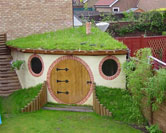
Cute or what?
The phenomenon of Green Roofs currently sweeping across Europe inverts our spatial perception by taking vegetation from the ground to the rooftops. Aside from their ecological benefits, nobody would deny the aesthetic improvement of replacing an ugly old rooftop with a floral delight.
Advocated by the UK Minister for housing, Yvette Cooper, these living roofs. come in two main types,
extensive, which needs little maintenance, consisting of laying moss or sedum as a fertile base to nurture wild vegetation, and intensive roofs, basically the creation of a more labour-intensive roof-top garden or patio. Aside from absorbing CO2 from the atmosphere, green roofs also take-in rainwater, meaning run-off and flooding is lessened, and they act as natural insulation by keeping heat from escaping. The figures suggest savings of 3-10% on your winter fuel bills Best of all, they provide an excellent way of attracting wildlife back to the city.
Although turf-topped buildings were popular in the 1930s, their current presence in the UK is much less than in Germany , Switzerland and Austria . In the Austrian city of Linz , there are 40 acres of green roofs to be found. That’s the equivalent of 40 football pitches! The British government provides no financial incentives to property developers, but Swiss environmentalists have had the opposite experience after research in the biodiversity found in urban areas. Swiss Federal law requires all new roofs larger than 100m squared to be constructed with vegetation.
British examples of these rabbit burrow-esque abodes are growing. Nottingham University library has taken to the turf, as has the Horniman Museum in London. Canary Wharf boasts the highest green roof in Europe covering the Barclay’s bank headquarters at 160m. Manchester’s city center, historically an industrial and polluted place, will see a landmark green roof erected this summer over the Piccadilly Pavilion.
If you are planning to green-roof your property, it is advisable to check with your local authority as rules over planning permission vary. But in some urban areas including a living roof in your plans for a new building can make it more favorable to the council. According to Dusty Gedge, one of the first pioneers of green roofs in the UK , someone who regularly practices DIY at home should not find the creation of a roof garden overly difficult. Certainly it is less costly than roofing with the usual materials like tar and bitumen.
Unlike the Chinese government’s extensive forest reclamation programs, the UK’s tree-planting efforts tend to manifest themselves mostly as local, community projects. However, by capitalizing on the acres of unused space available above the urban landscape, green roofs are helping to put a little more vegetation on the map.
For more information see www.livingroofs.org